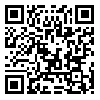Volume 26, Issue 2 (Summer 2019)
J Birjand Univ Med Sci. 2019, 26(2): 147-156 |
Back to browse issues page
Download citation:
BibTeX | RIS | EndNote | Medlars | ProCite | Reference Manager | RefWorks
Send citation to:



BibTeX | RIS | EndNote | Medlars | ProCite | Reference Manager | RefWorks
Send citation to:
Gholami K, Ziaei M, Sharifzadeh G, Anani Sarab G. Determine the distribution of a normal range of hematological factors in a sample of the adult population resident in Birjand- South Khorasan (2015). Journals of Birjand University of Medical Sciences 2019; 26 (2) :147-156
URL: http://journal.bums.ac.ir/article-1-2469-en.html
URL: http://journal.bums.ac.ir/article-1-2469-en.html
1- Student Research Committee, Birjand University of Medical Sciences, Birjand, Iran
2- Infectious Diseases Research Center, Birjand University of Medical Sciences, Birjand, Iran.
3- Social Determinants of Health Research Center Birjand University of Medical Sciences, Birjand, Iran
4- Infectious Diseases Research Center, Birjand University of Medical Sciences, Birjand, Iran. ,ghansa@yahoo.com
2- Infectious Diseases Research Center, Birjand University of Medical Sciences, Birjand, Iran.
3- Social Determinants of Health Research Center Birjand University of Medical Sciences, Birjand, Iran
4- Infectious Diseases Research Center, Birjand University of Medical Sciences, Birjand, Iran. ,
Abstract: (6844 Views)
Background and Aim: Hematological values in people are affected by various factors such as race, environment, time, test method, sample collection site, and age. Given the fact that these factors can differ with each other in different populations, these differences can lead to differences in the results of hematological reference rates. Therefore, we decided to identify a normal range of blood factors in a large sample of the adult population living in South Khorasan.
Materials and Methods: In this cross-sectional study in 2015, a crowd of 5,000 selected from cluster-based adults in Birjand in 2015 and hematological parameters were determined in 4360 healthy subjects. Finally, the data were described using descriptive statistics.
Results: The counts for the total white blood cells, red blood cells, Hemoglobin, Hematocrit, and Mean cell volume values for males and females were determined. The mean Hemoglobin values were 15.01±3.13 and 14.01±1.8 in male and female respectively and the mean Hematocrit was 45.81±7.52 and 42.59± 5.99 in males and females, respectively. The minimum leukocyte counts were lower than those reported in existing references. However, a higher rate of Eosinophil and Monocyte was obtained among the subjects.
Conclusion: Although in general, hematological factors in Southern Khorasan are similar to the values mentioned in other references, but in some cases, there are also differences that can be useful in evaluating them.
Materials and Methods: In this cross-sectional study in 2015, a crowd of 5,000 selected from cluster-based adults in Birjand in 2015 and hematological parameters were determined in 4360 healthy subjects. Finally, the data were described using descriptive statistics.
Results: The counts for the total white blood cells, red blood cells, Hemoglobin, Hematocrit, and Mean cell volume values for males and females were determined. The mean Hemoglobin values were 15.01±3.13 and 14.01±1.8 in male and female respectively and the mean Hematocrit was 45.81±7.52 and 42.59± 5.99 in males and females, respectively. The minimum leukocyte counts were lower than those reported in existing references. However, a higher rate of Eosinophil and Monocyte was obtained among the subjects.
Conclusion: Although in general, hematological factors in Southern Khorasan are similar to the values mentioned in other references, but in some cases, there are also differences that can be useful in evaluating them.
Type of Study: Original Article |
Subject:
Hematology
Received: 2018/03/30 | Accepted: 2019/03/6 | ePublished: 2019/06/19
Received: 2018/03/30 | Accepted: 2019/03/6 | ePublished: 2019/06/19
Send email to the article author
| Rights and permissions | |
 |
This work is licensed under a Creative Commons Attribution-NonCommercial 4.0 International License. |







